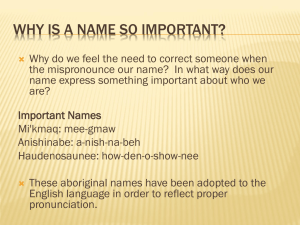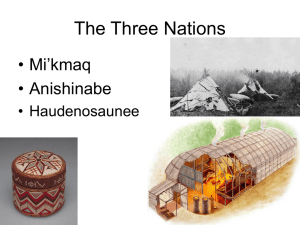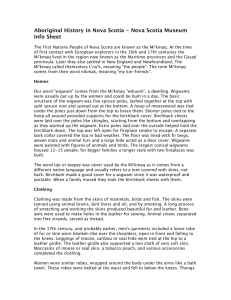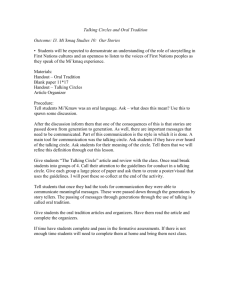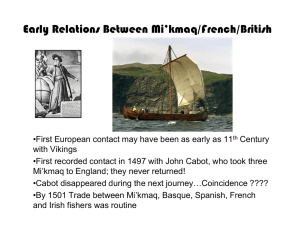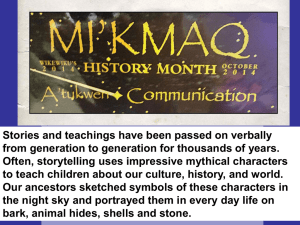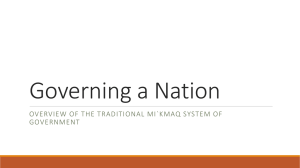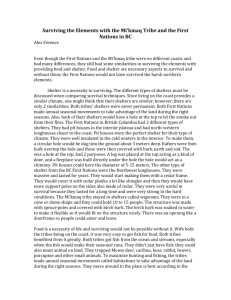Mi'kmaq Studies 10
advertisement
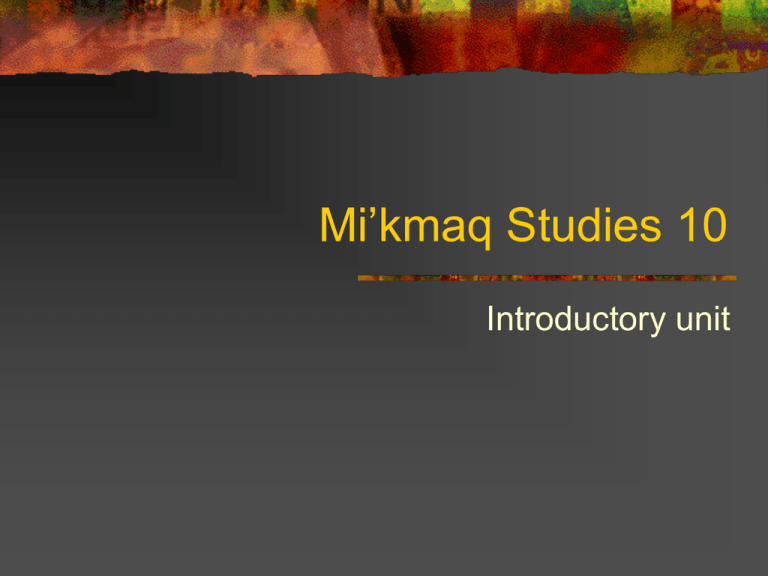
Mi’kmaq Studies 10 Introductory unit The Mi’kmaq: Who We Are The Native people of Nova Scotia all belong to the Mi’kmaq tribe. At the time of first contact with the European explorers in the 16th and 17th century they lived in what we now call the maritime provinces and the Gaspe peninsula. Later they also settled in New England and Newfoundland. The Mi’kmaq called themselves L’nu’k – the people The term Mi’kmaq comes from their word nikmak - my kin friends The Mi’kmaq: Who We Are Home Wigwam Could be built in a day and were put up by women Five spruce poles lashed together at the top with split spruce root and spread out at the bottom. Braced just down from the top with a hoop of moosewood shorter poles offered support to the birch bark cover. Birch bark sheets were laid over the poles starting from the bottom and overlapping as they worked up the wigwam. Birch bark was used because it was waterproof and portable. Top was left open for smoke to escape The Mi’kmaq: Who We Are A separate bark collar covered the top in bad weather Floor was lined with fir twigs, woven mats and animal fur A large hide acted as the door Painted with figures of animals and birds The largest wigwam housed 12-15 people (for larger families a longer style with two fireplaces was built) Wigwam 1930 St. Anne's Day, Chapel Island, Nova Scotia The Mi’kmaq: Who We Are Clothing Made from the skins of mammals, birds and fish. The skins were tanned by using animal brains, bird livers and oil and by smoking. Bone awls were used to make holes for sewing and animal sinew was separated into fine strands for thread. Decorated with geometric patterns and designs of birds, beasts and humans The Mi’kmaq: Who We Are Pigments used for painting were red and yellow ochre from the earth, charcoal and ground white shells. These were mixed with fish roe or birds’ egg yolk. Decorated with animal teeth, claws, bone and quills were sewn into clothing. Feathers were sometimes used as ornaments The Mi’kmaq: Who We Are Tools Made from animal bone, ivory, teeth, claws, hair, feathers, fur, leather, quills, shells, clay, native copper, stone, wood, roots and bark. For example axes – made from grinding stone to a sharp edge and a smooth surface. These tools were in turn used to cut and carve wood – fine carving was done with beaver teeth The Mi’kmaq: Who We Are Transportation The Mik’maq canoe was wide bottomed and raised at both ends with the sides curved upwards in the middle. This design allowed them to canoe far out to sea as well as in shallow streams and even in rapids 3-8 meters long Birch bark over a light wooden frame Could carry several hundred pounds but was light enough for one person to carry Toboggans were used in the winter to carry heavy loads over the snow canoe 1870-1885 ca Mi'kmaq oceangoing canoe The Mi’kmaq: Who We Are Food The Mi’kmaq spent about all but six weeks along the sea coast Salmon, sturgeon, porpoises, whales, walrus, seals, lobster, squid, shellfish, eels and seabirds and their eggs made up the bulk of their diet. They also ate moose, caribou, beaver, and porcupine as well as smaller animals like squirrels. Berries, roots and edible plants were gathered during the summer Meat and fish were dried and smoked to preserve them The Mi’kmaq: Who We Are Pastimes Storytelling – stories could last several days and included singing, dancing and feasting. Everyone smoked – tobacco made from red willow bark, bearberry leaves and native tobacco plants. Waltes was a favorite dice game (played today) Contests of running, wrestling and shooting Various ball games http://mathcentral.uregina.ca/RR/database/RR.09.00/t reptau1/ Mi’kmaq All cultures and societies change over time. However, few peoples have faced the deliberate and systematic attacks on their culture that the Mi’kmaq people have endured. The very survival of the Mi’kmaq language and culture is a testimony to the strength of the Mi’kmaq and their oral traditions, values and customs. Our Stories Storytelling has been an important way of teaching and learning in First Nations communities. Oral tradition provides cultural continuity through the sharing of stories, songs, history, personal experiences and social commentary. They reflect a unique world view and give meaning to the daily lives of individuals, families and the community. We will learn about special community events and ceremonies that sustain and nourish Mi’kmaq culture. Our Stories Read section 1.2 “Oral Traditions” in the text Maliseet and Micmac: First Nations of the Maritimes Pages 13-18 (up to and including oral history) Our Stories What is the importance of oral traditions and storytelling? How are oral works in contrast to the written word? Define creation stories and legends. What do they have in common? What can they be considered equivalent to? What is a tale? What do they describe? Describe storytelling. Why are they considered both entertainment and sources of information? Define Oral history Small group discussions – Our Stories In small groups identify what you believe to be the key elements of oral tradition Why has this system worked for so long? Our stories – group answers Key elements of oral tradition Provides cultural continuity Keeps the family and community strong Can relate to real life situations Can teach skill – cooking, building a house Source of cultural identity and personal pride Why has this system lasted for so long Stories were changed to be more relevant to the generation Captured the interest of the children It became tradition Source of entertainment It was the only way to remember the history – there was no other way to record them Questions After reading the stories from section 1.2 how can you compare them to other stories that you have read? In what ways are they the same? Different? What kinds of stories do people tell in your house? What is the oldest story you know?Is it written down? Was it always written down? Compare the differences in a person’s language in each of the following cases: Telling a story, talking on the phone, having a face-to-face conversation, through the use of technology? Wampum Wampum – used as a way of recording and sending messages. It consisted of purple and white beads made from the shells of quahog clams. The design of each string or belt indicated the type of message being sent and helped the messenger remember the specific contents. Considered very sacred and treated with great respect Wampum It was mainly used for the following: 1) Establish, maintain and terminate political relations. 2) Establish and maintain family relationships and make marriage proposals. 3) Show that people had positions of importance within a nation or local group. 4) To perform spiritual ceremonies. 5) To form alliances or make treaties and agreements with Europeans. Wampum See page 20 for examples http://www.cndm.com/english/Archives/Visit/2001-08Wampum.htm To make Wampum today 2 cups baking soda 1 cup cornstarch 1 ¼ cups cold water Stir and bring to a boil for 1 min Cover with a damp cloth and place on a cutting board until cool Knead and roll in a snake shape Cut in bead shapes put hole in with toothpicks Allow to dry for 24-36 hours String with heavy yarn and paint Wampum Read pages 18-24 Page 25 answer questions 6 & 7
